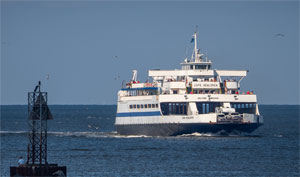Cape Henlopen, crisp white and dazzling under a deep-blue sky over Delaware Bay, made its slow approach to the breakwater at Cape May, N.J., the ferry’s captain mindful of the shallow harbor.
“The biggest issue is to avoid running aground,” said Capt. David Macomber as he eased the vessel out of the harbor. “We’re an hour into the flood (tide), and I’m showing 6 foot under the keel and the draft is 6 foot. When you see the barnacles on the rocks, you have low water.”
Clearing the harbor is only the beginning of Macomber’s concerns. The bay is littered with shoals, and there is a steady flow of tankers headed for Big Stone Anchorage.
“Cape Henlopen has very little hull in the water to hold it on a line,” said port captain Derek Robinson. “But we have a large tunnel bow thruster, and we have the engines and very large rudders to work with.”
The ferry, one of three passenger/vehicle carriers crossing Delaware Bay between Cape May and Lewes, Del., is named for the short peninsula cupping the beachfront at Lewes. Various forms of the ferry service date back to the late 19th century; the modern version was inaugurated on July 1, 1964, with a crush of politicians, VIPs and the general public at both terminals.
The 285-by-67-foot vessel, built in 1981 by BAE Systems Norfolk Ship Repair, can carry a mix of up to 100 vehicles and 800 passengers. M/V Delaware and M/V New Jersey, similar in dimensions and capacity, fill out the fleet.
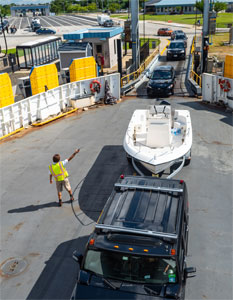 |
|
A deck hand directs traffic as the ferry takes on vehicles at the terminal in Lewes. |
Cape Henlopen’s enormous engine room is anchored by two Fairbanks Morse 38D8-1/8 opposing piston engines generating 2,000 hp with Philadelphia marine gears. The power plants gleam with care in a room where everything is in its place.
“I like the old Fairbanks,” said Nesmond King, the chief engineer. “There are no punches pulled with them, and over the years they’ve done their job well. But there is the environment and it’s difficult to get parts for them. So it’s time for a change.”
Budget pending, the old reliables are scheduled to be replaced this fall.
Life on deck is relaxing in the extreme with plenty of seating. There is a snack and drinks bar in the main lounge, and the outdoor bar on the upper deck proved to be a popular hangout on a sun-drenched day that included two dolphin sightings.
On the Lewes approach, Macomber moved to the port bridge wing control console, turned the ferry around, cut the corner around the lead pile by inches, and backed into the slip.
“Coming into Lewes, it all depends on the direction of the wind, and there is hardly a time when there is no wind,” he said. “But it’s like a roll of paper towels: When it blows up the middle, you’re all right. But when it is hitting the roll sideways, well …”
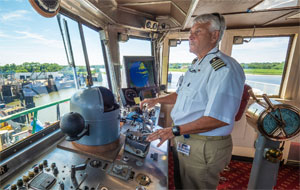 |
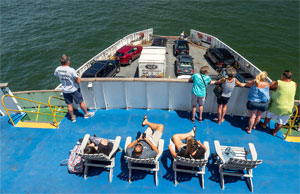 |
|
|
Capt. David Macomber backs the ferry from the Cape May terminal before making the 17-mile run across the mouth of the bay. |
Passengers relax on the upper deck and take in the scenery. |
|
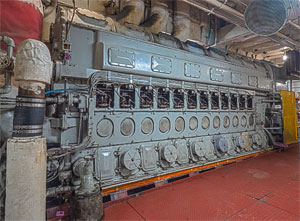 |
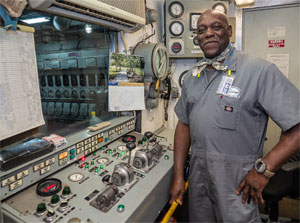 |
|
|
At the heart of Cape Henlopen are two Fairbanks Morse diesels that produce a combined 4,000 horsepower. |
“There are no punches pulled with them, and over the years they’ve done their job well,” says chief engineer Nesmond King. |
|
Cape Henlopen specifications |
| Owner/operator: Delaware River and Bay Authority, New Castle, Del. Builder: BAE Systems Norfolk Ship Repair, Norfolk, Va. Dimensions: L: 285’ B: 67’ D: 6.5’ Mission: Passenger and vehicle ferry Crew size: Nine |
|
PERFORMANCE CAPACITIES PROPULSION NAVIGATION |

